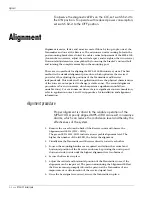
Stacking bistatic microwaves
a - 8 • • • MPS-4100 product guide
Stacking bistatic microwaves
Introduction
Bistatic microwave sensors have been used in security applications for many
years. Typically, microwave sensors provide a detection zone with a limited
height. One method of increasing the height of the detection zone is to stack two
transmitter-receiver pairs, with one pair mounted above the other (see
Figure a-8). This method of stacking microwave sensors can be used to detect
bridging attempts made with ladders or other climbing apparatus.
This Application Note outlines some of the advantages and disadvantages of
stacking the MPS-4100, Series 14000, Series 16000, and Series 24000 microwave
sensors.
Good practice
Follow the rules for site preparation, ground cover, clearances and unit
separation, as outlined in Do’s and Don’ts a planning primer.
The following steps MUST be taken in order to stack two microwave sensors:
1. Ensure that the two pairs have DIFFERENT modulation frequencies.
2. Ensure that the two pairs have DIFFERENT antenna polarizations for the
microwave signal. This will help prevent interference between the two sets of
microwave units.
•
Order one pair with the antenna elements rotated 90º, or for the
MPS-4100, rotate both antennas 90º prior to installation.
•
The lower pair should have horizontal polarization (wide beam), and the
upper pair should have vertical polarization (narrow beam).
3. For stand-alone (single zone) or perpendicular zone configurations, install
one transmitter and one receiver on each post (see Figure a-8). Ideally, the
two pairs fire in opposite directions.
Alternatively, the two transmitters or two receivers can be installed on the
same post (see Figure a-9). Generally, the choice is dictated by site wiring
considerations.
Figure a-8 Stacked standalone microwave detection zones
Beam centerline
Beam centerline
MW Detection zone
MW Detection zone
MW Detection zone
TX
RX
RX
TX











































